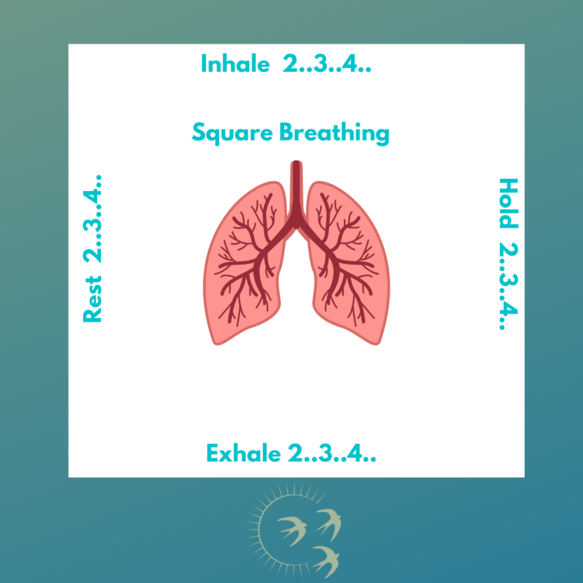
Square breathing pranayama yoga
I was recently waiting in the doctor’s surgery for a routine procedure that always make me apprehensive. Before seeing the doctor, a lovely nurse asked to take my blood pressure (BP). On taking my BP she looked at me in a puzzled way and asked if I had a heart condition as both my diastolic and systolic BP were sky-high. I have no history of heart issues or hypertension but I knew that my anxiety levels were raised and that was probably what was going on. I could feel all the tell-tale symptoms in my body, and my mind was most certainly racing. I asked the nurse for a couple of minutes to compose myself and during those moments I connected with my breath and did the Square Breath breathing yoga technique (pranayama). She re-tested my blood pressure and to her surprise, it had lowered to a very healthy range.
Living with Cancer can be very stressful from diagnosis onwards. Initially, so many examinations, scans and appointments to attend and the ongoing worry of what the future may hold. Moving into your active treatment phase means many more periods of high stress whilst you await surgery, have invasive and often harsh treatments such as chemotherapy and radiotherapy… the list goes on.
When active treatment ends you will still have routine follow-up scans and oncology appointments that can all be nerve-wracking and it’s very normal to you be left with a lingering fear that your cancer may come back.
Cancer and its treatments are traumatic both physically and mentally, I believe that a huge part of the healing process is calming a most likely, rattled nervous system as we know that a stressed body struggles to heal. Throughout treatment you have most likely been in survival mode, constantly in a state of fight/ flight or freeze, which is understandable and natural as it can all be very traumatic. However, once you come out of this active phase it’s important to learn ways to soothe your nervous system, as this ‘survival mode’ uses a lot of energy, energy that could be used for healing and recovery.
I believe that part of this approach is empowering yourself with a toolkit of relaxation and breathing techniques that you can use in stressful or anxiety-provoking situations, just like I did at the doctor’s surgery. In this post, I will introduce Square Breathing, a yogic breathing technique to add to your tool kit.
Square Breath
Square breathing is a type of yogic breath work (pranayama) that can quickly calm your nervous system, and reduce the stress in your body.
It is also referred to as box breathing, 4×4 breathing, or 4-part breath.
Here are instructions for square breathing.
Preparing for Square Breathing
If possible, it is usually a good idea to sit in a chair with your back supported. Place both of your feet on the floor. Take a moment to feel the support of the chair and floor under you.
Alternatively, you can sit in a seated position or lie down. The important thing is that your body is open to allow the breath to flow freely.
How to do it;
1. Begin by slowly exhaling all of your air out.
2. Then, gently inhale through your nose to a slow count of 4.
3. Hold at the top of the breath for a count of 4.
4. Then gently exhale through your mouth for a count of 4.
5. At the bottom of the breath, pause and hold for the count of 4.
If the image of a square works for you, you can imagine your breath and the pauses/holds in between the breath moving around the sides of the square.
When to use the Square Breath;
The beauty of this practice is that you can use it at any time, anywhere, it’s discreet, you can do it with your eyes open or closed and you don’t need any equipment.
To be able to use this technique in times of high stress or panic you first need to practice regularly and at a time when you are feeling calm, once you know how to do it with ease you can tap into it quickly and effectively at times when you feel less in control.
Beginners’ note
Square Breath can also be practised without the retentions (not holding your breath), just equalising your inhalation and exhalation. It is fine to reduce the count of the retentions in this practice if they are uncomfortable. You can build up by keeping the inhalation and exhalation both on a count of 4 and the retentions shorter (for example for a count of 2) until they feel more natural.
Precautions
Never strain the breath in Pranayama.
If you are pregnant, practise equalising the inhale and exhale without the retentions.
If you have high blood pressure, lung, heart, eye or ear problems it’s advised not to hold your breath after the inhale.
If you have low blood pressure it’s advised not to hold your breath after the exhale.
Do share how you find this practice and when you find it helpful in the comments below.
I would love to hear about other practices you find useful in managing times of high stress and anxiety.
Warmest wishes,
India xx